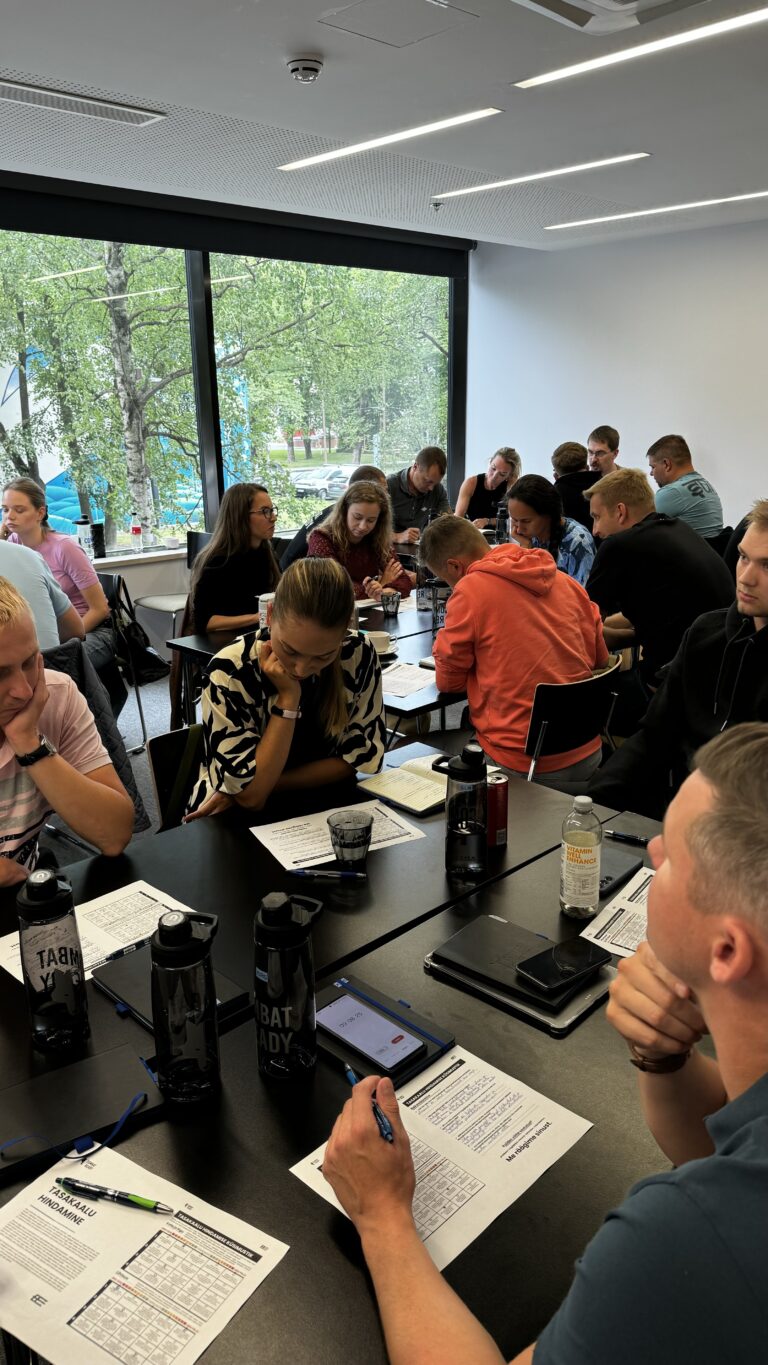
Employee story: “” I didn’t go to the exercise for my own sake “” or a summary of participating in the HEDGEHOG 2025 exercise
May 21, 2025
Combat Ready is now the patron of the Asian small-clawed otter at Tallinn Zoo!
August 28, 2025What is DEBRIEF aka reflection discussion?
And why should everyone start using it now?
One of the best leadership tools I’ve experienced in my life – and now teach to others – is the debrief, a simple yet highly effective way to enable continuous learning. A debrief is a short reflection held after an activity to identify key lessons and adjust future actions accordingly.
Debriefing is most commonly used in environments where teamwork, rapid learning, and continuous improvement are essential. In aviation, for example, debriefs are a standard part of every flight — pilots and crew review what went well and what could be improved next time. The same practice is used by rescue teams, military personnel, police officers, and in medicine — especially in emergency care and surgery, where a quick debrief follows each operation or critical incident.
Debriefing is also well known in the world of sports. Coaches and athletes carefully analyse each training session or competition to understand what went well and what needs improvement. The same principle applies in business — successful sales and leadership teams often conduct a debrief after an important meeting, project, or sales call to ensure an even better outcome next time.
My first personal experience with debriefing comes from my time in the Defence Forces. I especially remember two missions in Afghanistan, where we conducted a debrief after every activity — following patrols, operations, and even guard shifts. In those situations, this process could literally determine the safety and lives of myself and my fellow soldiers.
Today, we use the same principles in Combat Ready and teach them to leaders and teams.
What is DEBRIEF and why it is important?
A debrief is a short discussion (usually up to 30 minutes) held immediately after an activity or project. Its purpose is to create an environment where the team can learn from what was done and perform even better next time. Scientific studies confirm that a well-conducted debrief can improve team performance by 20–25%.
Top 5 barriers - and how to overcome them now
Although the debrief is a simple tool, it doesn’t always deliver its full potential — people often run into the same common barriers. Here are the five most frequent ones, along with a simple action to break through each:

1. Ego and defensiveness
Barrier: people are afraid of criticism and try to defend themselves.
How to break it: The leader should always go first. Admit when you’ve made a mistake: “I was wrong, and that decision wasn’t the right one.” When you lead by example, others will feel safe to be honest about their own mistakes too.
2. Lack of focus
Barrier: the debate will be scattered and fail to reach important lessons.
How to break it: Use these three simple questions: “What went right? What went wrong? What should change?” Put these questions somewhere visible for everyone — it helps the team stay focused.
3. Fier of hierarchy
Barrier: people are afraid to open up and speak honestly if there is no psychological safety in the team. Because of the hierarchy, there is a fear that honestly expressed thoughts may later be turned against them, especially if the leader does not lead by example.
How to break it: The leader must intentionally create a safe atmosphere and make it clear that “all opinions are equal.” Specifically invite input from those who usually stay quiet by asking, “How did you see it?” This builds confidence that every voice matters — and that speaking up won’t lead to consequences later.
4. Failure to act
Barrier: Thoughts remain thoughts, nothing changes.
How to break it: At the end of each debrief, write down one or two specific actions and immediately agree on who will do what — and when you’ll review the results together.
5. Lack of regularity
Barrier: Debrief feels like extra work and is done irregularly.
How to break: Keep it short and make it a daily thing – even 5-10 minutes after the meeting. Ongoing small discussions will increase the learning habit.
In my opinion, it’s the consistent use of these small steps that makes the biggest difference — this is how debriefing becomes a natural part of the work culture, rather than just a mandatory discussion.
Practical DEBRIEF Model (4 Steps)
1. What went RIGHT?
First, I focus on what went well. Things can only go well if we’ve previously agreed on what “good” looks like. This is the moment to highlight a teammate who did something exactly as planned. For example: “We agreed that everyone would keep their updates short during the meeting. Tiina stuck to that — she shared her points clearly and concisely, which helped us stay perfectly on schedule.” This way, we recognise the right behaviour and reinforce the agreed standard.
2. What went WRONG?
Here, the focus is on me and my own mistakes. Things went wrong where I didn’t follow the agreement. For example: “I promised to call the client on Monday but delayed it until Wednesday. As a result, the client had to check in themselves to see if things were moving.” Or: “I said I’d start the training with a clear overview of the agenda but forgot to do it, which caused confusion among participants.”
Such honest self-reflection shows that I take ownership of my mistakes instead of shifting the blame onto someone else.
3. What should CHANGE?
As the final step, I write down what I will do differently next time to make sure things go right and align with our agreement — how I will fix my own mistakes. For example: “Next time, I’ll schedule all client calls in my calendar right away so none of them get delayed.” Or: “I’ll always start meetings by clarifying the goal and desired outcome — even if it feels obvious.”
This step creates a bridge back to the first and second steps — I can see how the right behaviour strengthens the team, while also learning from my own mistakes to make things right next time.
All in all, the model comes down to: Right → Wrong → Change. We start by highlighting the positive and reinforcing the agreed standard, then take ownership of our mistakes, and finish with a clear plan for how to do things right next time. This keeps the debrief honest, focused on learning, and oriented towards the future.
4. Accountability Partner
Once you’ve identified your mistake and outlined your improvement plan, find yourself an accountability partner. This is someone from your team with whom you agree right away on a time to share how your change is progressing. It doesn’t need to be a long meeting — even a five-minute check-in is enough — but it must be consistent.
What matters most is that you actually open your calendar and set the time together. That’s another example of a “right action” — it reinforces the commitment and keeps you accountable for correcting your mistakes and following through on the change.
Important to remember
A debrief is, first and foremost, a tool for myself. I do it because I want to get better, learn, and grow through my actions. It’s not about pointing out others’ mistakes or giving negative feedback — it’s about my personal development and strengthening the team as a whole.
The Three Golden Rules of an Effective Debrief
- Quick and immediate – Hold the debrief right after the activity, while the experience is still fresh in everyone’s mind.
- Honest and constructive – Keep the conversation respectful and focus on what you are doing.
- Concrete and actionable – Agree what you or your team will actually change.
A debrief is a simple yet powerful tool that helps you and your team grow continuously. My advice: don’t let these five barriers slow down your team’s progress — use small, practical steps and make debriefing a daily habit.
When you do it consistently, debriefing becomes a natural part of your team’s DNA — and once that happens, nothing can stop your growth.
Are you ready to give it a try? Do your first small debrief today and share how it went. I’m here to help you with the next steps and practical tips — including a few you might not even think of at first.
Get after it!
Priit Lilleväli
Combat Ready instructor




